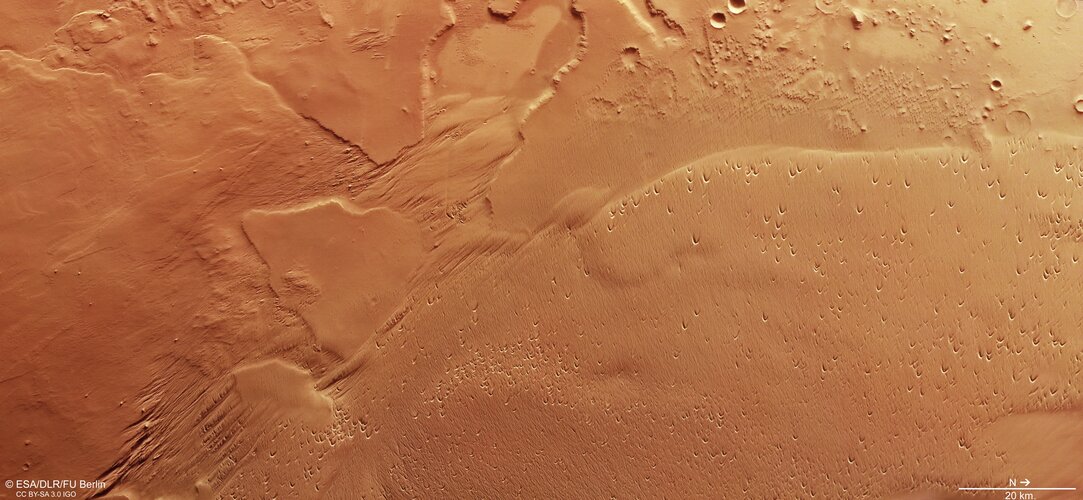
Copernical Team
Caution! Martian wind at work

This image from ESA’s Mars Express shows part of possibly the largest single source of dust on Mars: a wind-sculpted feature known as the Medusae Fossae Formation, or MFF.
Webb’s workhorse: NIRSpec
 Video:
00:01:00
Video:
00:01:00
The NIRSpec instrument is the workhorse near-infrared spectrograph on board the James Webb Space Telescope and is provided by ESA.
NIRSpec will allow scientists to study objects embedded in shrouds of gas and dust, to find out more about how galaxies formed and evolved, and to characterise the atmospheres of exoplanet to determine if water is present.
The primary goal of NIRSpec is to enable large spectroscopic surveys of astronomical objects like stars or distant galaxies. This is made possible by its powerful multi-object spectroscopy mode, which will make use of use of roughly a quarter of a
What ingredients went into the galactic blender to create the Milky Way
 Our galaxy is a giant 'smoothie' of blended stars and gas but a new study tells us where the components came from. In its early days, the Milky Way was like a giant smoothie, as if galaxies consisting of billions of stars, and an enormous amount of gas had been thrown together into a gigantic blender. But a new study picks apart this mixture by analysing individual stars to identify which origin
Our galaxy is a giant 'smoothie' of blended stars and gas but a new study tells us where the components came from. In its early days, the Milky Way was like a giant smoothie, as if galaxies consisting of billions of stars, and an enormous amount of gas had been thrown together into a gigantic blender. But a new study picks apart this mixture by analysing individual stars to identify which origin Galaxy collision creates 'space triangle' in new Hubble image
 A spectacular head-on collision between two galaxies fueled the unusual triangular-shaped star-birthing frenzy, as captured in a new image from NASA's Hubble Space Telescope. The interacting galaxy duo is collectively called Arp 143. The pair contains the glittery, distorted, star-forming spiral galaxy NGC 2445 at right, along with its less flashy companion, NGC 2444 at left.
Astronomers s
A spectacular head-on collision between two galaxies fueled the unusual triangular-shaped star-birthing frenzy, as captured in a new image from NASA's Hubble Space Telescope. The interacting galaxy duo is collectively called Arp 143. The pair contains the glittery, distorted, star-forming spiral galaxy NGC 2445 at right, along with its less flashy companion, NGC 2444 at left.
Astronomers s 'Tatooine-like' exoplanet spotted by ground-based telescope
 A rare exoplanet which orbits around two stars at once has been detected using a ground-based telescope by a team led by the University of Birmingham.
The planet, called Kepler-16b, has so far only been seen using the Kepler space telescope. It orbits around two stars, with the two orbits also orbiting one another, forming a binary star system. Kepler-16b is located some 245 light years fr
A rare exoplanet which orbits around two stars at once has been detected using a ground-based telescope by a team led by the University of Birmingham.
The planet, called Kepler-16b, has so far only been seen using the Kepler space telescope. It orbits around two stars, with the two orbits also orbiting one another, forming a binary star system. Kepler-16b is located some 245 light years fr The secret of Venus may be hidden in the heat of the night
 Despite being close to Earth and having nearly the same size, Venus is another world. Underneath its thick mantle of acid sulfuric clouds, at the surface 460 degrees Celsius are the rule. This temperature is kept by the greenhouse effect of a virtually carbon dioxide only atmosphere. Seventy kilometres above, one has to withstand a perpetual wind storm, the product of the so called Venus superro
Despite being close to Earth and having nearly the same size, Venus is another world. Underneath its thick mantle of acid sulfuric clouds, at the surface 460 degrees Celsius are the rule. This temperature is kept by the greenhouse effect of a virtually carbon dioxide only atmosphere. Seventy kilometres above, one has to withstand a perpetual wind storm, the product of the so called Venus superro Day of Discovery: 7 Earth-Size Planets
 Newspapers around the world printed the discovery on their front pages: Astronomers had found that a red dwarf star called TRAPPIST-1 was home to a close-knit family of seven Earth-size planets. NASA announced the system Feb. 22, 2017.
Using telescopes on the ground and in space, scientists revealed one of the most unusual planetary systems yet found beyond our Sun and opened the tantalizi
Newspapers around the world printed the discovery on their front pages: Astronomers had found that a red dwarf star called TRAPPIST-1 was home to a close-knit family of seven Earth-size planets. NASA announced the system Feb. 22, 2017.
Using telescopes on the ground and in space, scientists revealed one of the most unusual planetary systems yet found beyond our Sun and opened the tantalizi Rocky Road offers plenty of tasty science bites during Sols 3391-3394
 MSL planning was met with beautiful images of our path ahead, like this one. We ended up planning to look at many of these rocks with our science instruments before driving on. This is a busy plan, covering four sols due to the holiday on Monday. In order to keep things manageable, especially given that our uplink is early tonight, we are doing all of our activities on the last 3 sols of the pla
MSL planning was met with beautiful images of our path ahead, like this one. We ended up planning to look at many of these rocks with our science instruments before driving on. This is a busy plan, covering four sols due to the holiday on Monday. In order to keep things manageable, especially given that our uplink is early tonight, we are doing all of our activities on the last 3 sols of the pla The second-generation PRISMA Earth observation system gets underway
 Thales Alenia Space, the joint venture between Thales (67%) and Leonardo (33%), has signed a contract with the Italian space agency (ASI) to conduct a feasibility study for the PRISMA Second Generation (PSG) hyperspectral Earth observation system. It will be leading a consortium that includes Leonardo, Telespazio (the joint venture between Leonardo (67%) and Thales (33%)), e- GEOS and SITAEL.
Thales Alenia Space, the joint venture between Thales (67%) and Leonardo (33%), has signed a contract with the Italian space agency (ASI) to conduct a feasibility study for the PRISMA Second Generation (PSG) hyperspectral Earth observation system. It will be leading a consortium that includes Leonardo, Telespazio (the joint venture between Leonardo (67%) and Thales (33%)), e- GEOS and SITAEL. Monitoring Arctic permafrost with satellites, supercomputers, and deep learning
 Permafrost - ground that has been permanently frozen for two or more years - makes up a large part of the Earth, around 15% of the Northern Hemisphere. Permafrost is important for our climate, containing large amounts of biomass stored as methane and carbon dioxide, making tundra soil a carbon sink. However, permafrost's innate characteristics and changing nature are not broadly understood.
Permafrost - ground that has been permanently frozen for two or more years - makes up a large part of the Earth, around 15% of the Northern Hemisphere. Permafrost is important for our climate, containing large amounts of biomass stored as methane and carbon dioxide, making tundra soil a carbon sink. However, permafrost's innate characteristics and changing nature are not broadly understood. 
